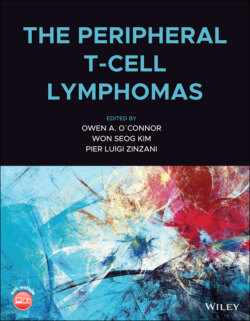Читать книгу The Peripheral T-Cell Lymphomas - Группа авторов - Страница 22
Oncogenic Events in the Transformation of T or Natural Killer Cells Genetic Lesions
ОглавлениеTumor transformation is driven by genetic events that modify a biological function. Among structural variants first described is the chromosomal translocation involving the ALK oncogene at 5q35 locus. In this translocation, ALK is fused to various partners, most often NPM (nucleophosmin), resulting in abnormal expression of ALK hybrid proteins in anaplastic large‐cell lymphomas (ALCL) [1]. Thus, anaplastic lymphoma kinase positive (ALK+) ALCL was the first genetically defined T‐cell lymphoma entity. With the development of high‐throughput sequencing methods, especially RNA sequencing, many other chromosomal translocations or gene fusions have subsequently been described in PTCL, deregulating various oncogenes such as DUSP22 [2], TP63 [2], VAV1 [3], CD28‐ICOS, or CD28‐CTLA4 [4, 5]. Besides these translocations and fusions, copy number variants (CNV) are frequent in PTCL. Some CNV are unique to some subtypes of the disease, including for example, gains in chromosomes 5 and 21 in IDH2R172‐mutated angioimmunoblastic T‐cell lymphomas (AITL) [6]. In addition, complex genetic changes appear frequent in GATA3‐positive PTCL not otherwise specified (PTCL‐NOS), which have a high frequency of alterations in PTEN‐PI3K and CDKN2A‐TP53 pathways, highlighting the implication of P53 loss in the development of genomic instability [6]. More rarely, chromothripsis, an episode of catastrophic chromosomal rearrangement [7], has been described [8], but no dedicated study has been conducted to evaluate its incidence.
Next‐generation targeted, whole‐exome or whole‐genome sequencing studies have reported single‐nucleotide variants or indel mutations in coding sequences, leading to the loss of function of a tumor suppressor gene, impacting epigenetic regulation or cell‐cycle control, or a gain of function of a proto‐oncogene, resulting for example in increased signaling, in most PTCL entities. Splice site mutations in tumor suppressor genes like TET2 or DNMT3A frequently occur and result in loss of function.
Coding sequences represent only a small fraction of the genome, and genetic events altering noncoding regions have been identified. Although the functional consequences of many of them are largely unknown, some events altering the noncoding region may have important biological consequences. For example, structural variants altering 3′ untranslated region (UTR) of PDL1 resulting in PDL1 overexpression and immune escape, have been described in adult T‐cell leukemia/lymphoma (ATLL) [9] or in extranodal NK/T‐cell lymphoma (ENKTL), nasal‐type [10], two diseases related to viral infections. Dysregulation of non‐coding RNA is also observed; some microRNA [11] or small nucleolar RNA [12] signatures are entity specific and could aid in diagnosis, while some may play a role in oncogenesis. However, the role of the anomalies affecting the non‐coding genome is largely unexplored.
Beyond the genetic and epigenetic anomalies, viruses can directly or indirectly play a role in the oncogenic transformation. Two viruses with oncogenic properties, human T‐cell lymphotropic virus type 1 (HTLV1) and Epstein–Barr virus (EBV) are causally linked to a spectrum of lymphoproliferations derived from T or NK cells (see below).
